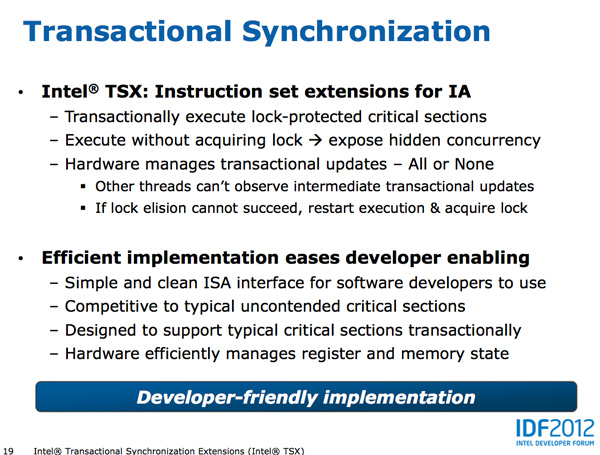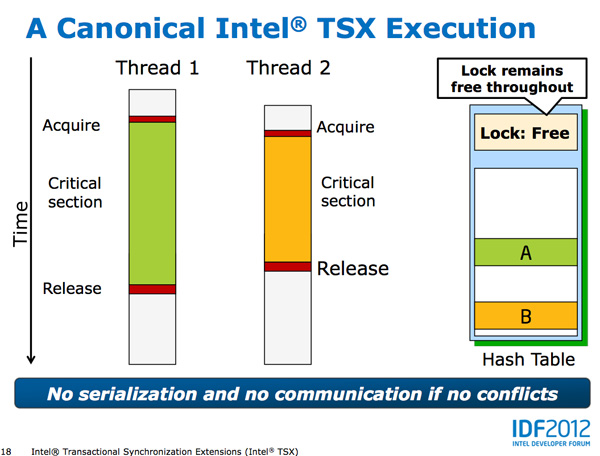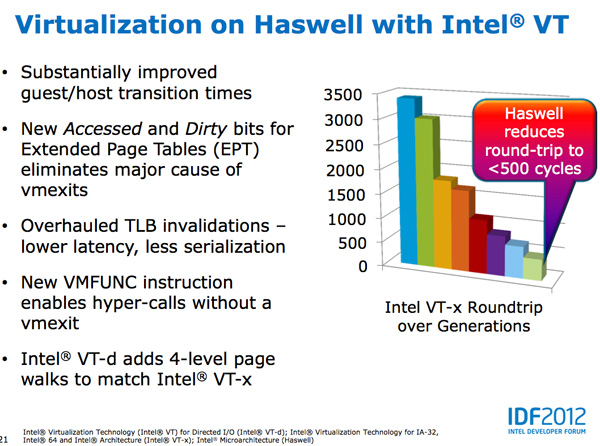Intel's Haswell Architecture Analyzed: Building a New PC and a New Intel
by Anand Lal Shimpi on October 5, 2012 2:45 AM ESTTSX
Johan did a great job explaining Haswell's Transactional Synchronization eXtensions (TSX), so I won't go into as much depth here. The basic premise is simple, although the implementation is quite complex.
It's easy to demand well threaded applications from software vendors, but actually implementing code that scales well across unlimited threads isn't easy. Parallelizing truly independent tasks is the low hanging fruit, but it's the tasks that all access the same data structure that can create problems. With multiple cores accessing the same data structure, running independent of one another, there's the risk of two different cores writing to the same part of the same structure. Only one set of data can be right, but dealing with this concurrent access problem can get hairy.
The simplest way to deal with it is simply to lock the entire data structure as soon as one core starts accessing it and only allow that one core write access until it's done. Other cores are given access to the data structure, but serially, not in parallel to avoid any data integrity issues.
This is by far the easiest way to deal with the problem of multiple threads accessing the same data structure, however it also prevents any performance scaling across multiple threads/cores. As focused as Intel is on increasing single threaded performance, a lot of die area goes wasted if applications don't scale well with more cores.
Software developers can instead choose to implement more fine grained locking of data structures, however doing so obviously increases the complexity of their code.
Haswell's TSX instructions allow the developer to shift much of the complexity of managing locks to the CPU. Using the new Hardware Lock Elision and its XAQUIRE/XRELEASE instructions, Haswell developers can mark a section of code for transactional execution. Haswell will then execute the code as if no hardware locks were in place and if it completes without issues the CPU will commit all writes to memory and enjoy the performance benefits. If two or more threads attempt to write to the same area in memory, the process is aborted and code re-executed traditionally with locks. The XAQUIRE/XRELEASE instructions decode to no-ops on earlier architectures so backwards compatibility isn't a problem.
Like most new instructions, it's going to take a while for Haswell's TSX to take off as we'll need to see significant adoption of Haswell platforms as well as developers embracing the new instructions. TSX does stand to show improvements in performance anywhere from client to server performance if implemented however, this is definitely one to watch for and be excited about.
Haswell also continues improvements in virtualization performance, including big decreases to guest/host transition times.














245 Comments
View All Comments
stop-a - Saturday, October 6, 2012 - link
100% agree on the well engineered part especially on the antenna gate when Steve God was saying "you're holding wrong", plus the recently ingeniously designed sapphire glass lens camera when Tim Schmok was saying "stay away from bright light source". Boy, Apple products must be engineered straight from the heaven; they are just too perfect for a mere earthling to use.Paer0 - Saturday, October 6, 2012 - link
@stop-a. Since you are a 100% Apple hater, let me ask you this what computer do you use? And what OS do you use on it? I hope it doesn't crash several times a day. I use a MacBook Pro 2012 and I don't see anything come close.Urizane - Saturday, October 6, 2012 - link
You really shouldn't use the 'crash several times a day' piece anymore. I'm annoyed every time I see this. My Windows 7 machine has an uptime of 20 days and counting. Most of the time, it waits for me to connect to it via SplashTop or FTP, or it's recording TV shows, but when I play games, I stress it bigtime. Seriously, stop with the Windows constantly crashes crap. It's just plain false now.P.S. - 20 days ago, I brought it to another house, thus the interruption in uptime.
StevoLincolnite - Saturday, October 6, 2012 - link
I have a Dual socket 2011 motherboard with dual Core i7 3930K's both chips clocked to 4.6ghz, 32gb of ram, Triple Radeon 7970 3gb cards powering 3x 27" Dell U2711 monitors in Eyefinity.Kay go. Lets see if your Mac can keep up or a Mac workstation at the same price. (Hint: Not going to happen.)
Besides, Mac's look ugly, I prefer the whole she-bang of a side window with a nice water cooling loop and having the whole thing light up, not some dull silver box.
Plus, my system is completely stable. Never had a crash yet with Windows 7 and... I have access to the last couple of decades worth of software and games, not to mention emulation of other platforms.
I can also pretty much find software and hardware easily and it will "just work" I never have to ask the question of: Will it work on a Mac?
lmcd - Saturday, October 6, 2012 - link
I don't think you're in their target audience, for some reason. They're the best preconfigured system out there, especially once you ignore price.Magik_Breezy - Sunday, October 14, 2012 - link
You'd hope a manufacturer can "configure" a system for an extra $1,400Hardware: $400
I'm Apple: $1,400
Total: $1,800
With PCs manufacturers almost always loose money selling motherboards
vt1hun - Tuesday, October 9, 2012 - link
Two Core i7s working on a dual 2011 socket motherboard? You need QPI links for that which only certain Xeons have. Sounds like your system will just NOT work !FunBunny2 - Tuesday, October 9, 2012 - link
If Steve hadn't done what Apple does best (according to Steve) "steal" BSD unix, would you still be crowing?Magik_Breezy - Sunday, October 14, 2012 - link
His operating system doesn't crash 7 times a day because he doesn't run OS X, I'll rephrase that, because he isn't a retardHisDivineOrder - Sunday, October 7, 2012 - link
Let's not forget the obscenely high failure rates due of Macbook Pro's because they are huge, metallic, and yet refuse to have vents ruin the smooth awesomeness of their aesthetic.Whoops, for many it won't last more than two years, if that. Hell, if you're lucky, your battery will give out before your laptop cooks. Regardless, look up what Apple suggests and you'll get:
Buy another one. Yours is old. ;)